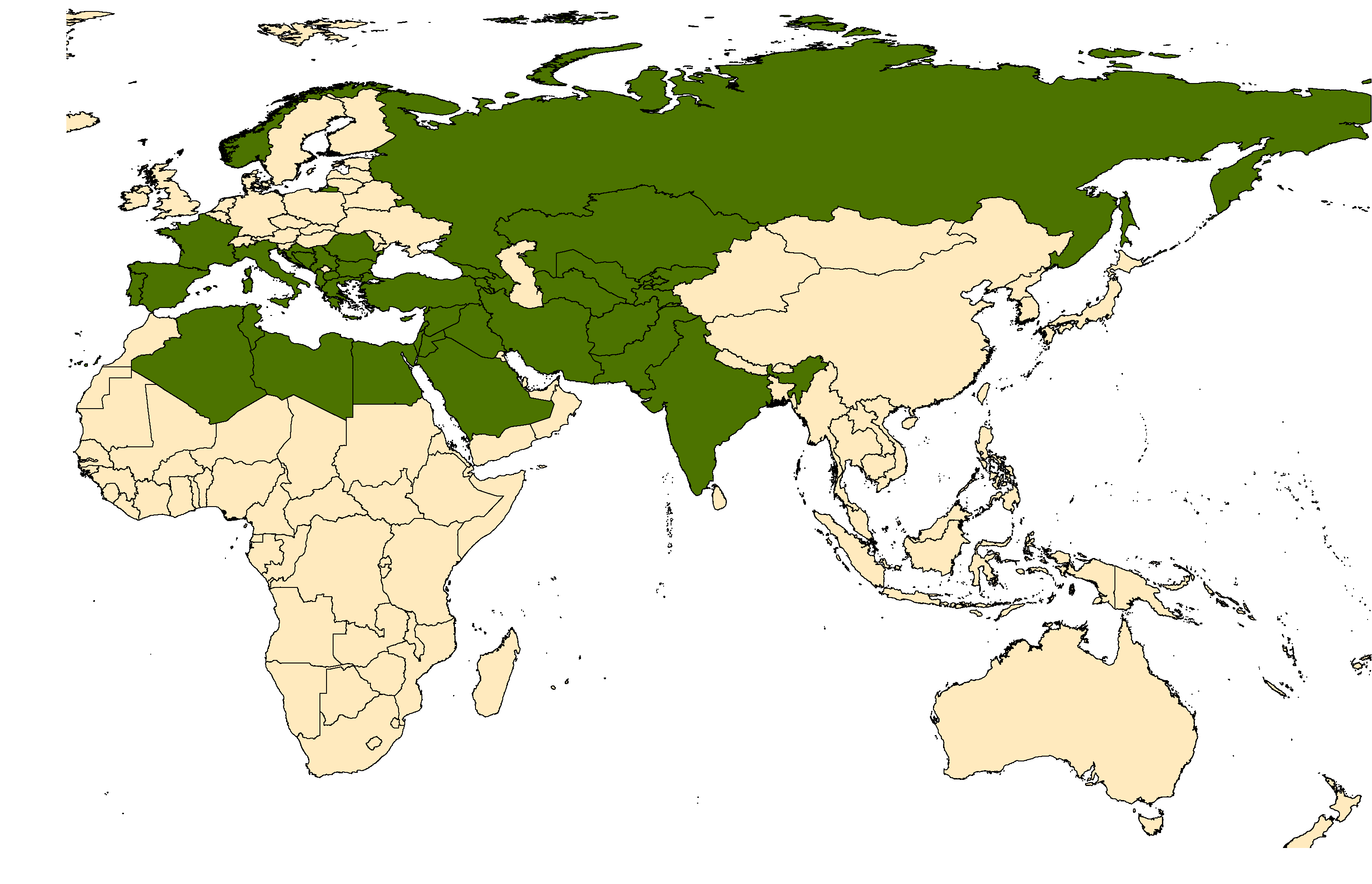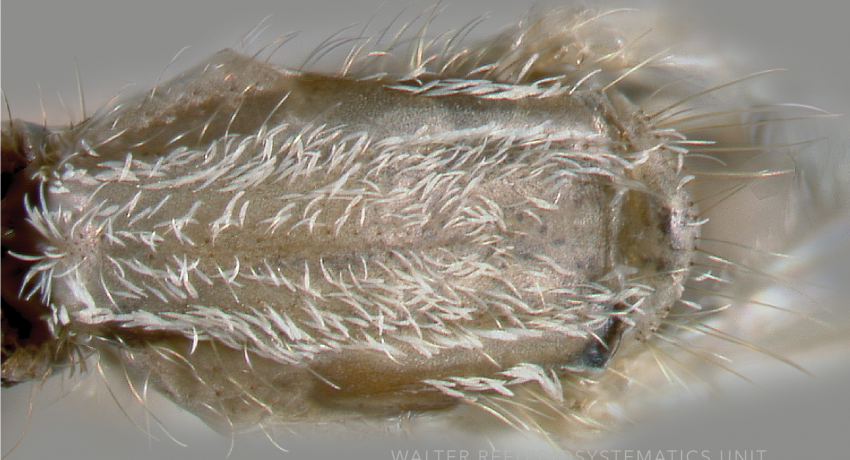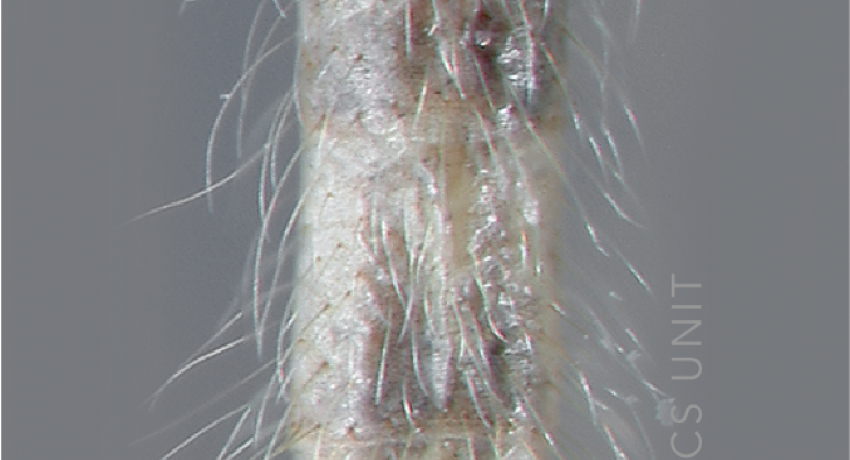PALEARCTIC & AFROTROPICAL REGIONS
Etymology: really (pictus)
Adult An. superpictus have many pale scales on the scutum and head vertex, and some flecked over the flagellomeres. The cuticle of the abdomen and abdominal setae are also pale. Anopheles superpictus is found along the south and eastern Mediterranean basin (including northern Africa and the Middle East), in eastern Europe, and into the Caucaus Region of the Western Palaearctic. Two forms of An. superpictus (A and B) have been reported in Iran, based on morphological differences in the larval and adult stages, mitochondrial DNA differences, and perceived differences in bionomics (climatic preferences and malaria competence). Three nuclear ITS2 genotypes (X, Y, Z) suggest further incipient speciation. Anopheles superpictus has eight recognized synonyms—palestinensis Theobald, nursei Theobald, cardamatisi Newstead & Carter, vassilievii Portschinsky, macedoniensis Cot & Hovasse, berestnevi Shingarev, atheniensis Cardamatis, and hellenicus Peus.
Type locality: Italy
Type depository: Location Unknown (LU)
DIAGNOSTIC CHARACTERS (Click photos to view; mouse over and click large photo to zoom in.)
ADULT (illustrated): Head: Palpus with 3 distinct pale bands; MPlp5 all pale; vertex with broad white scales, posterior and lateral scales dark brown. Thorax: Scutal fossa without scales; scutum with many narrow pale scales; upper proepisternal setae absent. Wing: One or two pale spots at base of costa, humeral pale and presector pale; presector pale spot present; accessory sector dark spot absent due to fusing of sector pale and accessory sector pale spots; pale fringe spot absent between cubital vein and vein 1A; vein 1A with two dark spots, distal spot much longer; most of vein R4+5 pale-scaled, with small basal and apical dark spots. Legs: Femura and tibia without speckling; Ta-III dark, some tarsomeres may be slightly pale apically; Fe-II,III without longitudinal white stripe. Abdomen: Terga (Te) not pale scaled, without distinct dark posterolateral scale tufts.
LARVA (not illustrated): Head: Seta 2-C widely separated; setae 2,3-C usually single, slightly aciculate; seta 4-C <0.67 length of seta 2-C. Thorax: Seta 1-P with weakly developed tubercle; setae 1,2-P basal tubercles not fused; seta 9-M branched and 10-M single; seta 3-T forming weakly palmate seta with 3–9 branches; setae 9,10-T branched. Abdominal segments: Segments III-VII with tergal plates not encompassing posterior accessory plates; width of tergal plate on segment V usually about 0.67 distance between palmate setae; seta 1-I not palmate; seta 1-II–VII well-developed, palmate; leaflets of seta 1-III,IV with long apical filaments; seta 6-IV usually 5-branched.
TAXONOMIC KEYS
Glick 1992
Voyadjoglou & Harbach 2001
Azari-Hamidian & Harbach 2009
Becker et al. 2010
![]()
WRBU – Anopheles – Afrotropical Region – Adult
![]()
WRBU – Anopheles – Afrotropical Region – Larva
![]()
WRBU - Genera - Global - Adult
![]()
WRBU - Genera - Global - Larva
![]()
WRBU - Genera - Eastern Palearctic - Adult
![]()
WRBU - Genera - Eastern Palearctic - Larva
![]()
WRBU - Anopheles - Republic of Georgia - Adult
Exemplar DNA sequences
An. superpictus COI: AY900634-50, JF966745, JX25703–JX255708
BIONOMICS
Immatures
Immatures An. superpictus are found in stagnant or very slow flowing, shallow stream pools in rocky river beds. Waters typically have high calcium salt concentrations, but there are reports of immatures collected in drying rice fields at elevation. Optimal temperatures for larval development occur between 30–35°C.
Adults
Anopheles superpictus is common in mountain valleys and foothills across its range, and has been reported at elevations of up to 2,800m in Tajikistan. Females are endophilic and readily enter homes to feed on man. In colder climates, the females enter diapause by the end of October, but will break out of diapause to feed in warm houses during the winter.
DISTRIBUTION NOTES
Afghanistan, Albania, Algeria, Armenia, Azerbaijan, Bosnia & Herzegovina, Bulgaria, Croatia, Cyprus, Egypt, France (includes Corsica), FYRO Macedonia, Georgia, Greece, India, Iran, Iraq, Israel (includes Gaza Strip & West Bank), Italy (includes Sicily), Jordan, Kazakhstan, Kyrgyzstan, Lebanon, Libya, Montenegro, Norway, Pakistan, Portugal (includes the Azores), Romania, Russia (includes Southern Districts), Saudi Arabia, Serbia, Spain, Syria, Tajikistan, Tunisia, Turkey, Turkmenistan, Uzbekistan.

WRBU VECTOR HAZARD REPORTS
VHR: Medically Important Mosquitoes of EUCOM
View other WRBU Vector Hazard Reports
Available GIS Models
An_superpictus_Dornak_1 Palaearctic
IMPORTANT REFERENCES (full citations below)
Grassi 1899: 560 (A)
Theodor 1925: 381 (E*)
Senevet 1930: 319 (P*)
Christophers 1933: 264 (M*, F*, P, L*, E)
Ross & Roberts 1943b: 27 (M*, F*, L*; taxonomy, distribution, bionomics)
Monchadskii 1951: 96 (L*)
Senevet & Andarelli 1956c (taxonomy)
Mattingly 1969c (E*)
Gutsevich et al. 1974: 114 (M*, F*, L*; taxonomy)
Glick 1992 (F*; key, taxonomy, distribution)
Amr et al. 1997 (distribution; Jordan)
Ramsdale & Snow 2000: 10 (distribution)
Hadjivassilis 2000 7: 38 (distribution; Cyprus)
Voyadjoglou & Harbach 2001 (F; key, distribution; Greece)
Oshaghi et al. 2007 (molecular taxonomy; s.l.)
Azari-Hamidian & Harbach 2009 (F, L; keys, distribution; Iran)
Sinka et al. 2010: 117 (bionomics review, distribution, niche model)
Becker et al. 2010: 185 (M*, F*, L*; keys, taxonomy, distribution, bionomics)
Habirov et al. 2012 (molecular taxonomy, bionomics, distribution; Tajikistan)
Robert et al. 2019 (distribution; western Palearctic)
CURRENT SYNONYMS
syn. palestinensis Theobald
1903a: 71 (M*, F*; Pyretophorus). Type locality: Several localities in Palestine [= Lebanon & Syria] & Cyprus (NHMUK).
syn. nursei Theobald
1907: 66 (F; Pyretophorus). Type locality: Quetta [Baluchistan, Pakistan] (NHMUK).
syn. cardamatisi Newstead & Carter
1910: 379 (M*, F*; Pyretophorus). Type locality: Athens [Attica], Greece (NHMUK).
syn. vassilievii Portschinsky
1911: 58 (A*; as variety). Type locality: Tashkent [Uzbekistan] & Golodnaya Steppe [Karaganda, Kazakhstan] (LU).
syn. macedoniensis Cot & Hovasse
1917: 890 (A*, L; Pyretophorus superpictus variety). Type locality: Macedonia, Greece (FMP).
syn. berestnevi Shingarev
1926: 48 (F; as var.). Type locality: Nr. Tashkent [Uzbekistan] (LU). References: Christophers 1933: 264 (synonymy).
syn. atheniensis Cardamatis
1931: 129 (A*; Pyretophorus). Type locality: Athens, [Attica], Greece (LU). References: Pandazis 1935: 4 (synonymy) [an earlier record of synonymy than that recorded by Ward 1984b: 269].
syn. hellenicus Peus
1954: 76 (E*). Type locality: Langadas Loutra, Thessaloniki, Macedonia, Greece (NE).
CITED REFERENCES
Amr, Z.S., Al-Khalili, Y.H., & Arbaji, A. (1997). Larval mosquitoes collected from northern Jordan and the Jordan Valley. Journal of the American Mosquito Control Association, 13(4), 375–378.
Azari-Hamidian, S., & Harbach, R.E. (2009). Keys to the adult females and fourth-instar larvae of the mosquitoes of Iran (Diptera: Culicidae). Zootaxa, 2078, 1–33.
Becker, N., Petrić, D., Zgomba, M., Boase, C., Madon, M., Dahl, C., & Kaiser, A. (2010). Mosquitoes and their control (Second ed.). Berlin Heidelberg: Springer-Verlag.
Cardamatis, J.P. (1931). Les espèces de moustiques en Grèce et tout particulierement d'Athenes. Bulletin de la Société de pathologie exotique (Paris), 24, 122–131.
Christophers, S.R. (1933). The fauna of British India, including Ceylon and Burma. Diptera.Vol. IV. Family Culicidae. Tribe Anophelini. London: Taylor and Francis.
Cot & Hovasse (1917). Quelques remarques sur les Anophélines de Macédoine. Bulletin de la Société de pathologie exotique (Paris), 10(10), 890–895.
Glick, J.I. (1992). Illustrated key to the female Anopheles of southwestern Asia and Egypt (Diptera: Culicidae). Mosquito Systematics, 24(2), 125–153.
Grassi, G. B., Bignami, A., & Bastianelli, G. (1899). Resoconto degli studi fatti sulla malaria durante il mese di gennaio. Accademia Nazionale dei Lincei. Rendiconti della Classe di Scienze Fisiche, Matematiche e Naturali (R C Accad Lincei), 8, 100–104.
Gutsevich, A.V. (1974). On the identification of mosquito females (Culicidae) by microscopic preparations of the head. IV. Key to species of the genus Aedes. Parazitologiya (St. Petersburg), 8(4), 329–335.
Gutsevich, A.V., Monchadskii, A.S., & Shtakel’berg, A.A. (1974). Fauna of the USSR. New series No. 100 Diptera. Vol. III, No. 4. Mosquitoes. Family Culicidae. Jerusalem, Israel: Keter Publishing House Jerusalem Ltd. (Original work published 1971).
Habirov, Z., Kadamov, D., Iskandarov, F., Komilova, S., Cook, S., McAlister, E., & Harbach, R.E. (2012). Malaria and the Anopheles mosquitoes of Tajikistan. Journal of Vector Ecology, 37(2), 419–427
Hadjivassilis, A. (2000). Mosquitoes (Diptera: Culicidae) of Cyprus. European Mosquito Bulletin, 7, 38.
Hay, S.I., Sinka, M.E., Okara, R.M., Kabaria, C.W., Mbithi, P.M., Tago, C.C., …Godfray, H.C.J. (2010). Developing global maps of the dominant Anopheles vectors of human malaria. PLoS Medicine, 7(2): e1000209.
Mattingly, P.F. (1969c). Mosquito eggs II. III. Tribe Anophelini. Mosquito Systematics Newsletter 1(3), 41–50.
Monchadskii, A.S.M. (1951). The larvae of bloodsucking mosquitoes of the USSR and adjoining countries (Subfam. Culicinae). Tableaux Analytiques de la Faune de l'URSS (Musee Zoologique de l'Académie des Sciences), 37, 1–290.
Newstead, R., & Carter, H.F. (1910). Descriptions of a new genus and three new species of anopheline mosquitos. Annals of Tropical Medicine and Parasitology, 4, 377–383.
Oshaghi, M.A., Shemshad, K., Yaghobi-Ershadi, M.R., Pedram, M., Vatandoost, H., Abaie, M.R., . . . Mohtarami, F. (2007). Genetic structure of the malaria vector Anopheles superpictus in Iran using mitochondrial cytochrome oxidase (COI and COII) and morphologic markers: a new species complex? Acta Tropica, 101(3), 241–248.
Peus, F. (1954). Ueber stechmuecke in Griechenland (Diptera, Culicidae). Bonner Zoologische Beitrage, 1, 73–86.
Portschinsky, J. (1911). Die malaria-mucke (Anopheles claviger F.) im Zusammenhang mit dem Sumpffieber, ihr Leben, ihre Eigenschaften und ihre Bekampfung. Trud. Byu. Ent., Spb., 5(1), 1–137.
Ramsdale, C.D., & Snow, K. (2000). Distribution of the genus Anopheles in Europe. European Mosquito Bulletin, 7, 1–26.
Robert, V., Günay, F., Le Goff, G., Boussès, P., Sulesco, T., Khalin, A., Medlock, J.M., Kampen, H., Petrić, D. & F. Schaffner. (2019). Distribution chart for Euro-Mediterranean mosquitoes (western Palaearctic region). Journal of the European Mosquito Control Association, 37, 1–28.
Ross, E.S., & Roberts, H.R. (1943b). Mosquito atlas. Part II. Eighteen old world anophelines important to malaria. Contributions of the American Entomological Institute.
Samanidou-Voyadjoglou, A., & Harbach, R.E. (2001). Keys to the adult female mosquitoes (Culicidae) of Greece. European Mosquito Bulletin, 10, 13–20.
Senevet, G. (1930). Contribution à l'étude des nymphes de culicides. Description de celles de certain anophelines et plus spécialement des espèces européennes et meditérranéennes. Archives de l'Institut Pasteur d'Algérie, 8, 297–382.
Senevet, G., Andarelli, L., & Duzer, A. (1956c). Études sur les stations à Anopheles multicolor des environs de Tenes (Algérie). Archives de l'Institut Pasteur d'Algérie, 34(1), 119–128.
Shingarev, N.I. (1926). New information on Culicidae of U.S.S.R. Tropichenskai Meditsina I Veterinariia, 2, 47–48.
Theobald, F.V. (1903a). A monograph of the Culicidae of the World (Vol. 3). London: British Museum (Natural History). 359pp
Theobald, F.V. (1907). A monograph of the Culicidae of the world (Vol. IV). London: British Museum (Natural History).
Theodor, O. (1925). Observations on Palestinian Anopheles. Bulletin of Entomological Research, 15, 377–382.
CITE THIS PAGE
Walter Reed Biosystematics Unit (Year). Anopheles superpictus species page. Walter Reed Biosystematics Unit Website, http://wrbu.si.edu/vectorspecies/mosquitoes/superpictus, accessed on [date (e.g. 03 February 2020) when you last viewed the site].












































































































































































